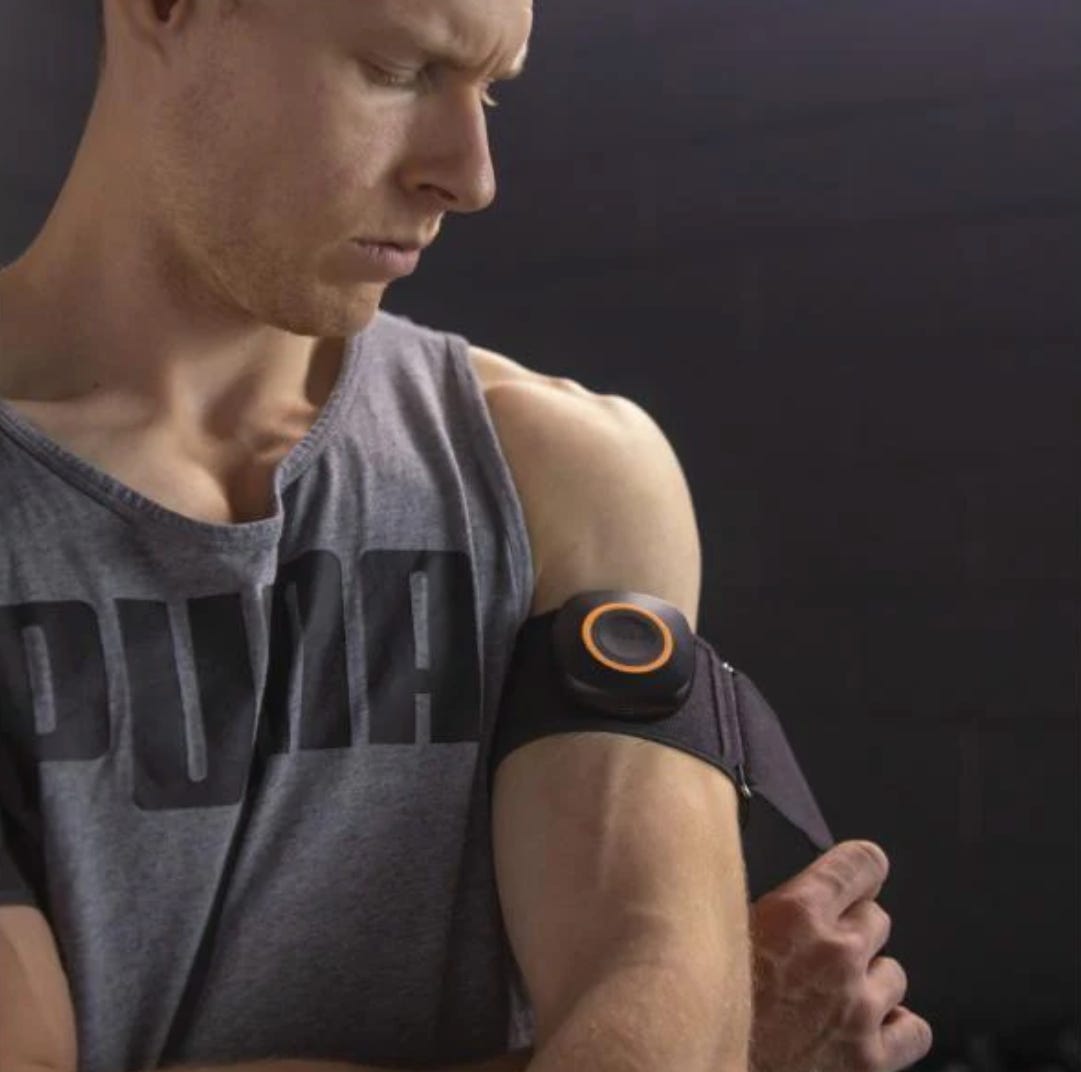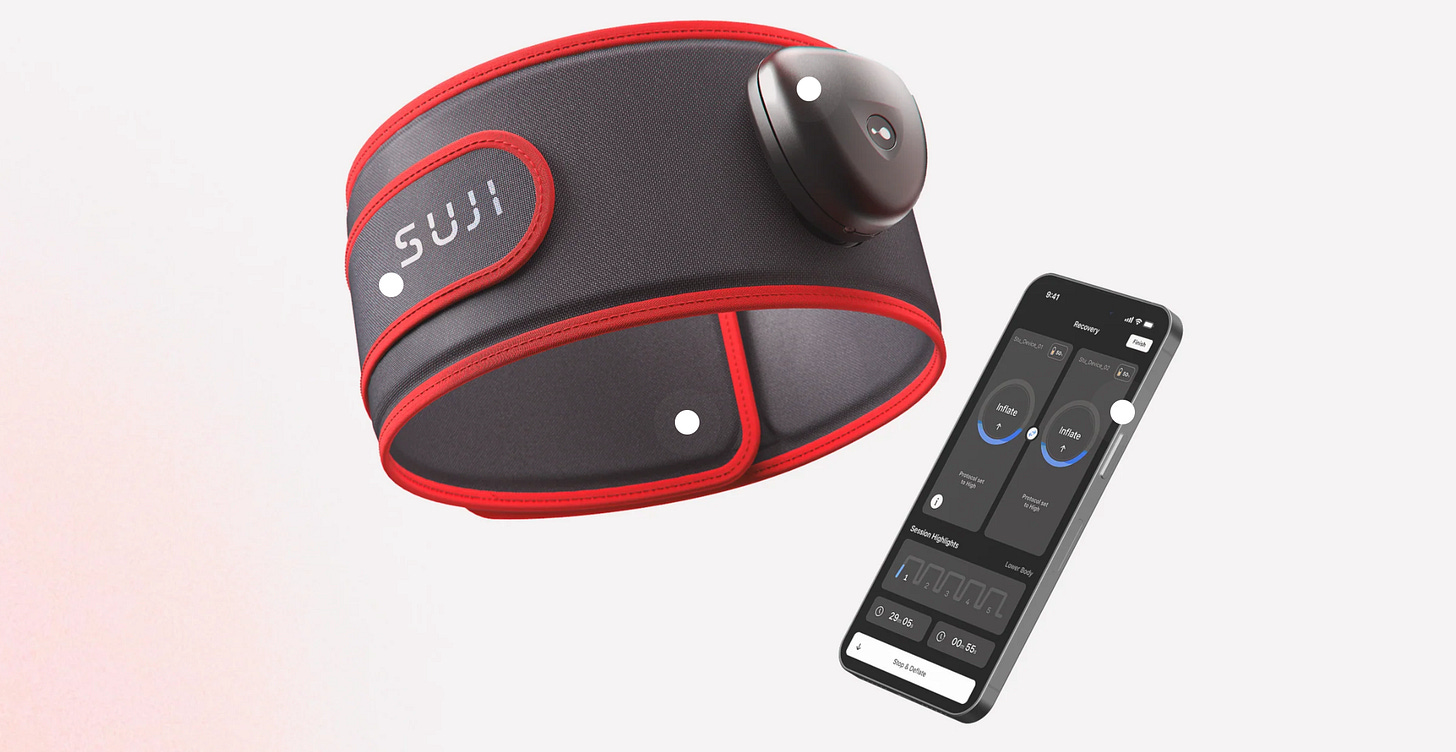💙 Upside Analysis: Blood Flow Restriction (BFR) Vendor Ecosystem Market Analysis: Key Drivers, Challenges, Stats, Use Cases, Vendors, Recommendations to Teams
Blood Flow Restriction (BFR) training has evolved from a fringe rehabilitation tool to a widely adopted, research-backed modality across elite sports, military, and clinical environments. The method involves applying external pressure—usually via cuffs or straps—to restrict venous return while maintaining arterial inflow. This creates a hypoxic environment in working muscles, promoting muscle hypertrophy, strength gains, and enhanced metabolic stress with significantly lighter loads. Originally popularized in Japan as “KAATSU training,” BFR is now a staple in the injury prevention and recovery protocols of professional teams globally.
As sports science becomes increasingly data-driven, teams seek methods to enhance performance with minimal wear and tear. BFR fits well within this framework by delivering training adaptations while reducing joint stress and neuromuscular fatigue. In this analysis, we explore the BFR market’s current landscape, emerging use cases, top vendors, technological innovations, and strategic recommendations for performance teams.
Market Size
As of 2024, the global BFR equipment market is valued between $130–$150 million, projected to grow at a CAGR of 9–11% through 2029. The elite sports segment—comprising pro teams, Olympic committees, national governing bodies, and Division I collegiate programs—is estimated to represent $30–$40 million, with substantial headroom for growth.
Key factors influencing this growth include:
Expansion of return-to-play protocols using BFR.
Increased research support for BFR efficacy.
Rising demand in tactical populations (military, special forces) influencing sports adoption.
More affordable and wearable systems entering the market.
Growing applications of BFR outside of rehab, including recovery, warm-ups, and travel.
Self-administered BFR devices allowing greater frequency of BFR use
The U.S., Europe (UK, Germany, France, Scandinavia), Japan, and Australia are currently the most active regions in terms of BFR adoption.
Key Use Cases for Elite Sports
A. Injury Rehabilitation
BFR significantly reduces muscular atrophy during immobilization and accelerates post-injury muscle and tendon healing. It is widely used after ACL reconstruction, Achilles repairs, meniscus surgeries, and upper-limb injuries.
B. Post-Surgery Strength Maintenance
BFR allows injured athletes to engage in resistance training with light loads while minimizing risk, especially critical in early post-op phases.
C. Recovery
BFR has been shown to reduce muscle soreness and support the restoration of neuromuscular function, helping athletes accelerate recovery when used passively or in combination with established active recovery strategies.
D. Load Management
During congested schedules or in aging athletes, BFR helps maintain fitness without exacerbating joint stress or neuromuscular fatigue.
E. Strength/Hypertrophy Development
Studies show BFR induces comparable strength and hypertrophy adaptations to high-load resistance training—making it valuable for in-season programming.
F. Neuromuscular Priming
Used as a pre-match or pre-training warm-up tool to “prime” motor units without heavy mechanical load.
G. Offsite/Travel Training
Compact and portable BFR systems are ideal for maintaining training quality while traveling or during deload phases.
Key Adoption Rates and Current State
NFL/NBA/MLB/NCAA: A growing number of teams have integrated BFR across their whole performance continuum, including rehab, warm ups, training, and recovery.
MLS and FIFA Teams: Adoption is growing rapidly, especially for travel and in-season rehab. Clubs like Liverpool FC and Bayern Munich have formalized BFR as part of load management.
Olympic Teams: USA, UK, Australia, Japan, and Norway Olympic teams include BFR in standard medical and S&C programming.
Tactical/Military: U.S. SOCOM, Canadian Forces, and Japanese Self-Defense Forces are using BFR as a core part of operational readiness and recovery.
Practitioner surveys: A 2023 PubMed‑indexed survey showed nearly 60% of sports medicine physicians in the U.S. currently use BFR, primarily for ACL rehab, with 75% adopting it within the last 1–5 years. Source here
Studies
Recent research on BFR training in elite sports highlights several key benefits and applications:
Enhanced Muscle Strength and Hypertrophy: BFR enables significant muscle growth and strength gains using low-intensity exercises (20-30% of 1RM) by increasing Type II muscle fiber recruitment and anabolic hormone release (growth hormone, IGF-1).
Muscle Soreness and Neuromuscular Recovery: Recovery BFR improves power production and sprint performance both immediately and 24 h after intermittent occlusion, and reduces indices of muscle damage. Studies here and here.
Warm up efficiency: Ischemic pre-conditioning, or BFR used furing a warm up routine, improves maximal performance in athletes while increasing pain tolerance. Study here.
Improved Aerobic Capacity: Some studies show BFR can enhance vascular adaptations such as increased capillary density and better endothelial function, contributing to aerobic performance improvements.
Versatility: BFR is effective for strength, hypertrophy, and endurance training, especially useful for athletes who cannot perform high-load exercises due to injury or fatigue.
Rehabilitation and Recovery: Widely used in rehab, BFR helps athletes recover by strengthening muscles without heavy loads, particularly beneficial for overhead athletes like baseball players.
Additional Benefits: Emerging evidence suggests BFR may improve bone health and reduce pain sensitivity, adding to its value in elite athletic training and recovery.
Key Drivers
Robust Clinical Evidence: Systematic reviews and RCTs continue to validate BFR’s efficacy in muscle development, rehabilitation, and vascular health.
Joint-Sparing Training: Enables high stimulus with minimal mechanical load—ideal for athletes with overuse injuries.
Speed of Results: Rapid hypertrophy and strength improvements within weeks.
Technological Advancement: Bluetooth-enabled cuffs, integrated apps, and AI-based pressure modulation have made BFR easier to adopt.
Portability: Modern BFR devices are lightweight and easy to use without supervision—perfect for travel or remote rehab.
Cross-Disciplinary Use: S&C, physio, medical, and coaching staff are all stakeholders, which helps justify investment.
Key Challenges
Pressure Calibration: Without precise control, over-occlusion can increase risks of ischemia, nerve damage, or poor recovery.
Education Gaps: Many staff rely on anecdotal or self-taught protocols. Lack of certification can lead to misuse or inefficiency.
Vendor Variability: From FDA-cleared pneumatic systems to low-cost manual cuffs, product quality and accuracy vary widely.
Cost vs. Scale: Premium systems are often cost-prohibitive for small colleges or low-budget teams.
Integration Issues: Most BFR vendors lack native integrations with mainstream athlete monitoring systems like Catapult, Kitman Labs, or Sparta Science.
Perception Issues: Some coaches still view BFR as “rehab only” and not a performance tool.
Key BFR Vendors
Here is a comparison of the BFR products.
Source: Upside Global, Vendors, July 2025
Kaatsu
Kaatsu devices utilize a pneumatic occlusion system with a dedicated control unit, catering to a broad range of users including clinical, military, and aging populations. They are known for their long-standing presence and research in the BFR field. Their official website is https://kaatsu.com/
AirBands
AirBands offers a Blood Flow Restriction (BFR) training solution with a wireless, automated cuff system that integrates seamlessly with your mobile or tablet via Bluetooth. These durable, sweat-resistant cuffs contain a medical-grade air bladder and inflate/deflate automatically to a personalized pressure—calibrated based on your systolic blood pressure—eliminating the need for manual pumps. It is available in arm and leg sizes (Regular and XL), AirBands are tailored to fit a wide range of users and are designed for both rehabilitation and performance training. Their convenience, backed by decades of BFR research, makes them a powerful tool for building muscle and strength with lower intensity workouts. You can explore their products at airbandsbfr.com.
B STRONG
B STRONG provides a more accessible manual BFR system that incorporates app and visual cueing for guidance, targeting budget-conscious teams and general fitness enthusiasts. Their emphasis is on making BFR training more widely available. You can explore their products at https://bstrong.training/
Hytro
Hytro is the world’s first wearable BFR system designed to fit your workflow; safe, simple, autonomous BFR, scalable across full teams. Built for sport and proven by research, Hytro makes it easy for coaches to integrate BFR into warm-ups, training, and recovery routines, without supervision or traditional specialist equipment. Alongside its game-changing technology, Hytro provides expert education and support to help coaches confidently integrate BFR within their program.
Trusted by elite teams across the NFL, NBA, Premier League, and World Tour Cycling, Hytro’s patented technology transforms complex BFR science into simple, scalable tools, bridging science and practice, turning a previously niche supervised technique into a self-administered daily advantage. Built to outperform. Learn more at https://hytro.com/
Suji BFR
Suji BFR offers a cost-effective and simple approach to blood flow restriction through their elastic resistance-based bands, making them ideal for general fitness and home workout routines. Their design focuses on ease of use and portability without the need for complex monitoring systems. To explore their range of bands, visit their website at https://sujibfr.com/
Future Use Cases for BFR
Cognitive Training Integration: Using BFR during technical drills to simulate fatigue-induced decision-making scenarios.
BFR + VR/AR Rehab: Combining BFR with virtual therapy to engage CNS while restricting peripheral blood flow.
AI-Optimized Protocols: Personalized occlusion pressures based on force plate, EMG, and HRV data.
Preventative Rehab: Regular BFR sessions to maintain tendon health and reduce chronic overload injuries.
Youth & Aging Athletes: Safe hypertrophy without joint wear, allowing early-phase strength development or maintenance in aging populations.
Future Technical Evolution
Smart Self-Adjusting Cuffs: Cuffs that auto-titrate pressure based on biofeedback in real time.
AMS Integration: Real-time upload of session data into athlete management platforms.
Haptic & Voice Coaching Feedback: Embedded AI coaches to guide occlusion sessions remotely.
Lightweight Embedded Fabrics: Garments with pressure-sensitive threads to enable “smart compression.”
Battery-Free Wireless Systems: New materials enabling inflation without external batteries, improving portability.
Recommendations to Teams
Invest in Education & Certification: Choose staff training alongside BFR devices. Vendors like SmartCuffs and Kaatsu offer online and in-person certifications.
Standardize Protocols: Develop use-case-specific BFR templates (e.g., post-ACL, return-to-play, in-season deload).
Incorporate Into AMS Platforms: Record BFR sessions in your athlete management software for visibility across departments.
Trial Multiple Systems: Pilot low-cost or wearable options before committing to a system-wide rollout.
Leverage in Travel Scenarios: Use garments (e.g., Hytro) or mobile cuffs during away games or camps for consistent training stimuli.
Monitor for Outcomes: Track force output, soreness, and wellness post-BFR sessions to identify high responders.
Evaluate ROI Beyond Rehab: View BFR as a performance tool for strength and endurance—not just a rehab aid.
Conclusion
Blood Flow Restriction (BFR) is no longer a fringe tool but a validated, scalable, and increasingly sophisticated performance and recovery modality. In elite sports, where injury mitigation, load management, and marginal gains are critical, BFR offers a compelling ROI. Despite challenges around education, cost, and standardization, the technology’s portability, scientific backing, and evolving ecosystem make it a must-have for performance and rehab departments.
As the market matures, we will likely see tighter integration of BFR into athlete monitoring systems, increasing automation, and broader usage across youth, tactical, and even esports populations. Teams that strategically adopt and systematize BFR now will be well-positioned to lead in the next wave of athlete health and performance innovation.
You may also like:
💪 Upside Analysis: Velocity Training Vendor Ecosystem: Key Drivers, Challenges, Use Cases, Vendors, Recommendations to Teams
Velocity-based training (VBT) represents a paradigm shift in strength and conditioning—from static percentages to dynamic, real-time feedback. By measuring the speed at which an athlete moves a load (typically a barbell), coaches can infer intent, fatigue, neuromuscular readiness, and training adaptations. VBT allows practitioners to move beyond guesswo…








